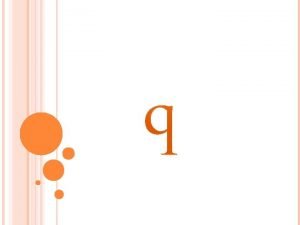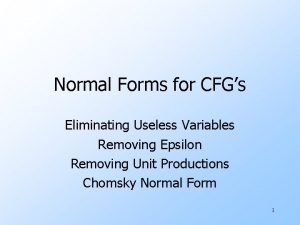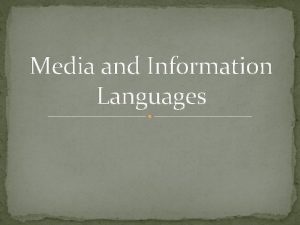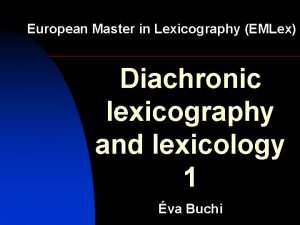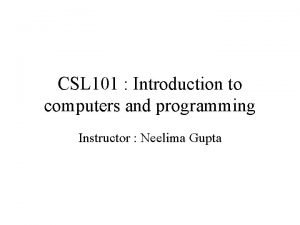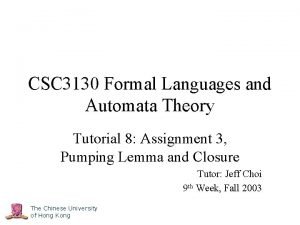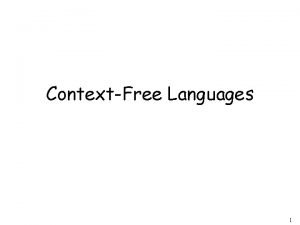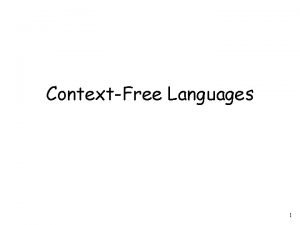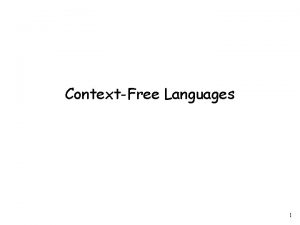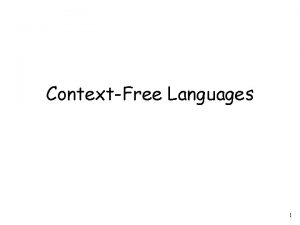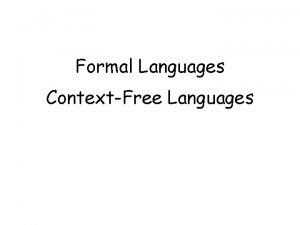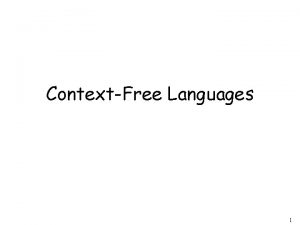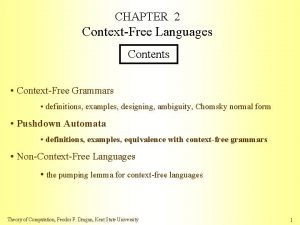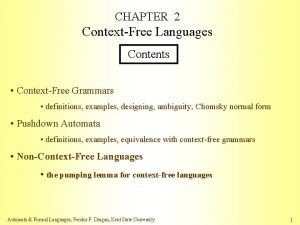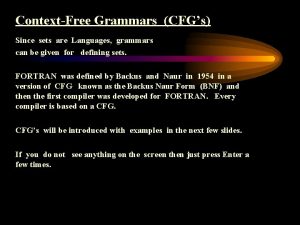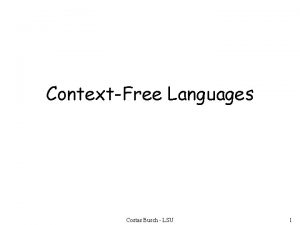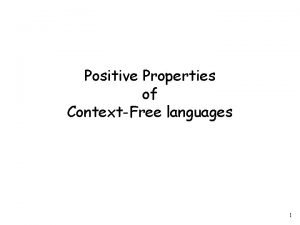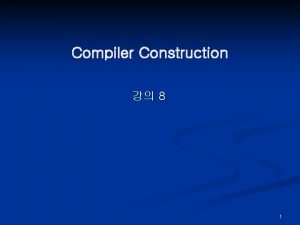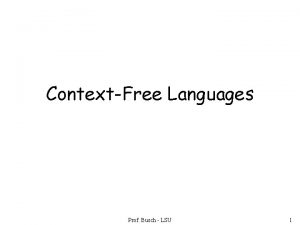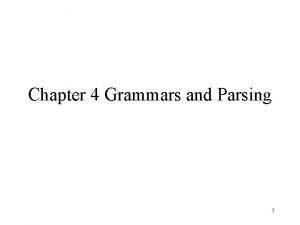Chapter 3 ContextFree Grammars ContextFree Grammars and Languages
















- Slides: 16

Chapter 3 Context-Free Grammars

Context-Free Grammars and Languages n Defn. 3. 1. 1 A context-free grammar is a quadruple (V, , P, S), where Ø Ø n V is a finite set of variables (non-terminals) , the alphabet, is a finite set of terminal symbols P is a finite set of rules of the form V (V )*, and S V, is the start symbol A production rule of the form A w, where w (V )*, applied to the string u. Av yields uwv, and u and v define the context in which A occurs. Ø Because the context places no limitations on the applicability of a rule, such a grammar is called context-free grammar (CFG) 2

Context-Free Grammars and Languages n Defn. 3. 1. 2. Let G = (V, , P, S) be a CFG and v (V )*. The set of strings derivable from v is defined recursively as follows: i) Basis: v is derivable from v ii) Recursion: If u = x. Ay is derivable from v and A w P, then xwy is derivable from v iii) Closure: All strings constructed from v and a finite number of applications of (ii) are derivable from v n The derivability of w (V )* from v (V )+ is denoted v n w , or v w, v w The language of the grammar G is the set of terminal strings derivable from the start symbol of G 3

CFG and Languages n Defn. 3. 1. 3. Let G = (V, , P, S) be a CFG (i) A string w (V )* is a sentential form of G if S w G * (ii) A string w * is a sentence of G if S w G * (iii) The language of G, denoted L(G), is the set { w * | * S w} Ø n A set of strings w over an alphabet is called a CFL if there is a CFG that generates w Leftmost (Rightmost) derivation: a derivation that transforms the 1 st variable occurring in a string from left-to-right (right-to-left) e. g. , Fig. 3. 1(a) and (b) exhibit a leftmost derivation, whereas Fig. 3. 1(c) shows a rightmost derivation n The derivation of a string can be graphically depicted by a derivation/parse tree 4

CFG and Languages 5

CFG and Languages n Design CFG for the following languages: (i) The set { 0 n 1 n | n 0 }. (ii) The set { aibjck | i j or j k }, i. e. , the set of strings of a’s followed by b’s followed by c’s such that there are either a different number of a’s and b’s or a different number of b’s and c’s, or both. n Given the following grammar: S A 1 B A 0 A | B 0 B | 1 B | Give the leftmost and rightmost derivation of the string 00101 6

CFG and Languages n * Defn. 3. 1. 4. Let G = (V, , P, S) be a CFG and S G w a * derivation. The derivation tree, DT, of S w is an G ordered tree that can be built iteratively as follows: (i) Initialize DT T with root S (ii) If A x 1. . . xn, where xi (V ), is a rule in the derivation applied to r. Av, then add x 1. . . xn as the children of A in T (iii) If A is a rule in the derivation applied to u. Av, then add as the only child of A in T e. g. , Fig. 3. 2 for Fig. 3. 1(a) S AA a. AAA aba. AA ababaa Fig. 3. 3 for Fig. 3. 1(a). . . (d) § Example. Let G be the CFG. . P = S z. MNz, M a. Ma | z, N b. Nb | z which generates strings of the form zanzanbmzbmz, where n, m 0 7

3. 2 Examples of Context-Free Grammar (CFG) n Many CFGs are the union of simpler CFGs, i. e. , combining individual grammars by putting their rules S 1, S 2, . . . , Sn together using S, the start symbol: S S 1 | S 2 |. . . | Sn n Example. Consider the language { 0 n 1 n | n 0 } { 1 n 0 n | n 0 } Step 1. Construct the CFG for the language { 0 n 1 n | n 0 } S 1 0 S 1 1 | Step 2. Construct the CFG for the language { 1 n 0 n | n 0 } S 2 1 S 2 0 | Step 3. Construct the CFG for the language { 0 n 1 n | n 0 } { 1 n 0 n | n 0 } S S 1 | S 2 S 1 0 S 1 1 | S 2 1 S 2 0 | 8

3. 2. Examples of CFG n Example. Consider the following grammar: S a. Sa | b. Sb | a | b | where S a. Sa | b. Sb capture the recursive generation process and the grammar generates the set of palindromes over {a, b} n Example. Consider a CFG which generates the language consisting of even number of a’s and even number of b’s: S a. B | b. A | A a. C | b. S B a. S | b. C C a. A | b. B n {S: even a’s and even b’s} {A: even a’s and odd b’s} {B: odd a’s and even b’s} {C: odd a’s and odd b’s} Example. Same as above except odd a’s and odd b’s S a. B | b. A A a. C | b. S B a. S | b. C C a. A | b. B | 9

4. 5 Chomsky Normal Form n n A simplified normal form which restricts the length and composition of the R. H. S. of a rule in CFG Defn 4. 5. 1. A CFG G = (V, , P, S) is in chomsky normal form if each rule in G has one of the following forms: i) A BC ii) A a iii) S where A, B, C, S V, and B, C V - { S }, and a n The derivation tree for a string generated by a CFG in chomsky normal form is a binary tree 10

Chomsky Normal Form n Theorem 4. 5. 2. Let G = (V, , P, S) be a CFG. There is an algorithm to construct a grammar G’ = (V’, ’, P’, S’) in chomsky normal form that is equivalent to G Proof (sketch): (i) For each rule A w, where |w| > 1, replace each terminal symbol a w by a distinct variable Y and create new rule Y a. (ii) For each modified rule X w, w is either a terminal or a string in V+. Rules in the latter form must be broken into a sequence of rules, each of whose R. H. S. consists of two variables. Ø n Example 4. 5. 1 One of the applications of using CFGs that are in Chomsky Normal Form - Constructing binary search trees to accomplish “optimal” time and space search complexity for parsing an input string 11

3. 5 Leftmost Derivations and Ambiguity n Theorem 3. 5. 1 Let G = (V, , P, S) be a CFG. A string w L(G) iff there is a leftmost derivation of w from S. Proof. It is clear that if there is a leftmost derivation of w from S, w L(G). We can show that every string in w L(G) is derivable in a * w, is a leftmost derivation. leftmost manner, i. e. , S If there is any rule application that is not leftmost, the rule applications can be reordered so that they are leftmost. n Is there a unique leftmost derivation for every string in a CFL? Ø Ø Ø Answer: No. (Consider the two leftmost derivations in Fig. 3. 1. ) The possibility of a string having several leftmost derivations introduces the notion of ambiguity. The ambiguity increases the burden on debugging a program, which should be avoided. 12

3. 5 Leftmost Derivations and Ambiguity n n Defn. 3. 5. 2 A CFG G is ambiguous if there is a string w L(G) that can be derived by two distinct leftmost derivations. A grammar that is not ambiguous is called unambiguous. Example 3. 5. 1 The grammar G, which is defined as S a. S | Sa | a is ambiguous, since there are two leftmost derivations on aa: S aa and S Sa aa however, G’, which is defined as S a. S | a, is unambiguous. n n Unfortunately, there are some CFLs that cannot be generated by any unambiguous grammars. Such languages are called inherently ambiguous. A grammar is unambiguous if, at each leftmost-derivation step, there is only one rule that can lead to a derivation of the 13 desired string.

3. 5 Leftmost Derivations and Ambiguity n Example 3. 5. 2 The ambiguous grammar G, S b. S | Sb | a can be converted into unambiguous grammar G 1 or G 2, where n G 1: S b. S | a. A A b. A | G 2: S b. S | A A Ab | a Example 3. 5. 3 The following grammar G is ambiguous: S a. Sb | a. Sbb | (in Example 3. 2. 4), since S a. Sb aa. Sbbb aabbb, and S a. Sbb aa. Sbbb aabbb which can be converted into an unambiguous grammar S a. Sb | A | A a. Abb | abb 14

3. 5 Leftmost Derivations and Ambiguity n Example. An inherently ambiguous language L = { anbncm | n, m 0 } { anbmcm | m, n 0 } Ø Every grammar that generates L is ambiguous Ø Consider the following grammar of L: S S 1 | S 2 , S 1 c | A, A a. Ab | S 2 a. S 2 | B, B b. Bc | Ø the strings { anbncn | n 0 } always have two different DTs, e. g. , S S S 1 S 2 c S 1 c …… S 2 a a S 2 …… 15

3. 5 Leftmost Derivations and Ambiguity n Another example of inherently ambiguous language: L = { anbncmdm | n, m > 0 } { anbmcmdn | n, m > 0 } n The problem of determining whether an arbitrary language is inherently ambiguous is recursively unsolvable. Ø n i. e. , there is no algorithm that determines whether an arbitrary language is inherently ambiguous. Reference: “Ambiguity in context free languages, ” S. Ginsburg and J. Ullian, Journal of the ACM, (13)1: 62 - 89, January 1966. 16
 Which grammar generates regular language
Which grammar generates regular language Unrestricted grammar examples
Unrestricted grammar examples Questions on context free grammar
Questions on context free grammar Eliminate useless symbols
Eliminate useless symbols Chomsky hierarchy
Chomsky hierarchy Real-time systems and programming languages
Real-time systems and programming languages Cs 421
Cs 421 Modern languages for life and work
Modern languages for life and work Importance of media and information languages
Importance of media and information languages Explain front end and back end of compiler in detail
Explain front end and back end of compiler in detail Proto language
Proto language Defence centre for languages and culture
Defence centre for languages and culture Difference between strongly and weakly typed languages
Difference between strongly and weakly typed languages List the primitives that specify a data mining task
List the primitives that specify a data mining task Media and information literacy performance task
Media and information literacy performance task Formal languages and automata theory tutorial
Formal languages and automata theory tutorial Formal languages and automata theory tutorial
Formal languages and automata theory tutorial


